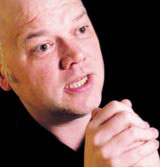Lone rangers protect a client’s best interest
Trish Lorenz talks to some senior industry figures who have decided to break away from the constraints of large consultancies and make a go of it on their own

Breaking away to set up your own group is hardly news. The design industry has always been fragmented – smaller outfits and freelance designers proliferate. But lately a swathe of senior creatives have taken the step of branching out on their own – the likes of Gabriel Murray, Franco Bonadio, Marksteen Adamson and digital designer Malcolm Garrett.
At this level of seniority, we’re not talking about freelances who implement projects with in-house client teams or alongside consultancies. These people are big hitters, offering strategic and creative input previously only available at big name groups.
Spurning the company ethos, this new breed is taking a different approach. And they remain solidly independent. Even the Lone Ranger didn’t ride into view without his trusty companion Tonto. But most of these senior creatives are offering their experience and skills without the backing of any organisation or clerical support.
Bonadio left his last corporate pay cheque behind in September last year when he decided to move on from C21. Previously creative director at Enterprise IG, Bonadio says he felt brand consultancies were losing direction – no longer focusing on the needs and objectives of the broader business world. But, he adds, he doesn’t want to run his own company.
‘It’s a fragmented industry in which it’s difficult to differentiate, there are thousands of design groups doing the same thing. There are so many design groups, why produce another one?’
Tim Rich agrees. A former magazine editor, he has spent the past six years as a writer and says 95 per cent of his business is working with designers for corporate clients. He remains independent because of ‘the ability to constantly redefine what you’re doing’.
‘Being independent means you can define what you do project by project,’ he says. ‘I don’t have any limitations about the type of company I work for, from large to small. A business is much less flexible in both the type of clients and type of work it does.’
Murray, former creative director at both Fitch and Rodney Fitch & Co, concedes the ‘freedom to do what you want, not curtailed by a management structure’ played a part in his decision to go independent. But he stresses the key factor was a perceived shift in client requirements.
‘We’re in a design renaissance,’ Murray maintains. ‘The big brand experience is over; it’s back to reality, dealing with real issues. Clients want expertise, but not necessarily the back up of a big group.’
And being independent doesn’t mean taking on smaller, less challenging work. The collaborative nature of the design industry in the 21st century means it’s possible to ‘do important work for big clients without being a large company’, Rich believes.
He advocates putting together a specialist team on a project-by-project basis. Recent work with a philosopher, designer, corporate communications and brand specialists bears that out. Rich maintains this approach benefits everyone – participants learn from broader disciplines and clients get the benefits of a unique mix of skills.
‘Within a company there is the implicit suggestion that it is a hermetically sealed organisation. You don’t look beyond the company people to find expertise. But you can get more unusual results with [genuinely] mixed skill sets,’ says Rich.
Murray agrees. For him, being independent enables designers to be ‘flexible in delivery’, choosing to involve other groups, client teams or no-one at all as appropriate. ‘You can use experts when you need them or even new talent when you need it,’ Murray says.
Bonadio believes clients can also benefit from working with just one person. ‘[Working on your own provides] clear head space – you’re not fire-fighting or constantly under pressure from clients and meetings, trying to find space to squeeze in quality thinking time.’
Bonadio continues, ‘You’re in control and it’s more balanced. I can really give a project the thinking time it deserves. Creative work is more focused and decisive, less volume needs to be produced or seen to be produced. Moreover, clients know the senior person is doing the work and delivering.’
Rich concurs. As an individual you ‘care about what you are doing because your reputation is on the line – everything counts towards your reputation’. And it’s more difficult to manage this in a business, he says.
Although all agree that a key benefit to clients is ‘very good value, senior expertise without the overheads’, Murray says its wrong to think that independents ‘come cheap’.
‘It’s definitely not a cost issue. It’s a value issue. [Client] costs are better directed, better apportioned,’ he says.
For senior types thinking of going it alone, both Rich and Bonadio stress the importance of having a network of contacts.
‘At a group you often have several senior people around you for advice, support and help,’ says Bonadio. ‘It’s important for independents to set up a group of people who can give support and critique work. Find people through the work you do and actively seek out people you respect for advice.’
And Rich warns it can be easy to ‘work too hard’. ‘You have to be extremely aware of the time things take – clients need time, attention and energy and you also need to do your own management accounts and professional development. It can be easy to work too hard and get tired and lose the quality of your work.’
Freedom, creativity and broader horizons – it’s easy to see the appeal of an independent lifestyle. As the pressure grows on creative directors across the sector, with clients squeezing costs and deadlines, it will be interesting to see if more senior figures are lured into a life alone on the range.
-
Post a comment



